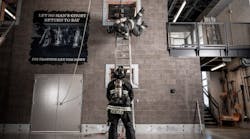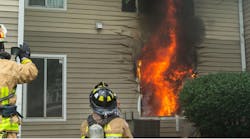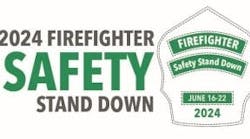COURSE: PROTECTIVE ENVELOPE AND FOAM
SESSION REFERENCE: 3-1
TOPIC: HANDLING HOSELINES AND FOAM APPLICATION - LECTURE/PRACTICAL
TIME REQUIRED: 3 HOURS
MATERIALS: Overhead Projector, MFRI OHT's, Hose and appliances, Foam and foam equipment
REFERENCES: IFSTA Essentials, 3rd ed.
PREPARATION:
MOTIVATION:
The student will be utilizing basic concepts for hose and appliances usage. Practice in these areas will ensure speedy and efficient use on the fireground.
OBJECTIVE (SPO): 3-1 T-PEAF-3-1-1
The student will be able to demonstrate utilizing hoselines and foam applicators, from memory, without assistance, to an accuracy of 70% and the instructor's satisfaction.
OVERVIEW: T-PEAF-3-1-2
Handling Hoselines/Foam Application
* Types of Fuel
* Principles
* Determining Application Rate
* Assembling a Foam Fire Stream
* Tactical Considerations for Foam Operations
* Nozzle Usage
* Advancing Line
* Assemble Foam Equipment
* Method of Applying Foam
SESSION 3-1 HANDLING HOSELINES AND FOAM APPLICATION LECTURE/PRACTICAL
SPO 3-1 The student will be able to demonstrate utilizing hoselines and foam applicators, from memory, without assistance, to an accuracy of 70% and the instructor's satisfaction.
3-1-1 Identify the differences between hydrocarbon and polar solvent fuels and the types of foam concentrate for each.
3-1-2 Define the basic principles of foam generation and extinguishment.
3-1-3 Determine the minimum application rate for fire extinguishment when given fuel surface size and type, and type of foam concentration used.
3-1-4 Identify how to assemble the components of a fire foam stream system utilizing an in-line foam proportioner.
3-1-5 Describe tactical considerations for foam operations.
3-1-6 Demonstrate how to open, close, and adjust stream patterns and flow settings for various size nozzles.
3-1-7 Demonstrate advancing a hoseline.
3-1-8 Demonstrate the assembly and the operation of a foam fire stream arrangement.
3-1-9 Demonstrate the method for applying a foam stream. (NFPA 472,3-4.4.1)
I. Types of Fuels (3-1-1)
A. Hydrocarbon
1. Petroleum based
2. Lighter than water
3. Vapors suppressed by foam as it floats on fuel surface
B. Polar solvent
1. Has attraction for water (like that of positive and negative magnetic poles)
2. Alcohol resistant formulations of foam necessary for extinguishment
II. Principles (3-1-2)
A. Extinguishment
1. Smothering - preventing air and flammable vapors from combining
2. Separating - intervening between the fuel and the fire
3. Cooling - lowering the temperature of fuel and adjacent surfaces
4. Suppressing - preventing release of flammable vapors
B. Generation
1. Terms
a. Foam concentrate - raw liquid in container
1) 5 gallon pail
2) 55 gallon drum
3) Apparatus storage tank
b. Foam eductor uses the venturi principle to draw foam concentrate into the water steam
c. Foam proportioner – injects correct amount of concentrate into water steam to make foam
solution
d. Foam solution - mixture of concentrate and water discharge from proportioner through the
hoseline
e. Finished foam - completed product after solution reaches nozzle and is aerated
2. Necessary elements
a. Foam concentration
b. Water (90-99% solution)
c. Air
III. Determining Application Rate (3-1-3)
A. Concentrates must be used only at specific percentages for which they are designed to be proportioned (1, 3, 6 percent)
B. Percentage concentrations
1. Foams for hydrocarbon fires - 1-6 percent concentrations
2. Foams for polar solvent fires - 6-10 percent concentrations
3. Medium and high expansion foams - 1,2, or 3 percent concentrations
4. FFFP or AFFF small air/solution ratio - 5:1 to 10:1
C. Application rates
1. AFFF and FFFP - .10 gpm foam solution per square foot
2. Polar solvent fires - .24 gpm foam solution per square foot
3. Protein, fluoroprotein foams - .16 gpm foam solution per square foot
4. Unignited spills may require less application rate due to lack of radiant heat, open flame, or thermal
draft
5. Application problem
a. 12' X 100' spill of #2 fuel oil = 1200 square feet
b. AFFF application rate - .10 gpm solution per square foot of fire
c. 120 gpm solution (.10 X 1200) simply stated: "10% of the fire area equals gpm foam water
solution"
IV. Assembling a Foam Fire Stream (in-line proportioner) (3-1-4)
A. Select proper foam concentrate for involved fuel
B. Check eductor and nozzle for hydraulic compatibility
C. Check concentration listing
1. Must match eductor percentage rating
2. If adjustable, set to proper concentration setting
D. Attach eductor to hose capable of flowing rated capacity of eductor and nozzle
1. Avoid hose kinks
2. Prevent water turbulence that will adversely affect eductor operation
a. Avoid connections to discharge elbows
b. Make sure valves are completely open
E. Connect attack hoseline and nozzle to eductor
F. Place open foam concentrate containers at the eductor so operation may be carried out uninterrupted
G. Place eductor suction hose into concentrate - bottom of concentrate must be no more than six feet (2m) below the eductor
H. Increased water supply pressure as required
I. At conclusion of operation, rinse and clean all foam appliances, tanks, and pumps with lukewarm water whenever possible.
V. Tactical Considerations for Foam Operations (3-1-5)
A. Desirable qualities of foam
1. Flows freely and covers fuel surface rapidly
2. Forms tough cohesive blanket and is vapor tight
3. Resists heat and fuel pick up, thus resisting break down
4. Retains and holds water to seal against hot metal surface (wicking)
B. Tactical considerations (2-dimensional combustible and flammable liquids incidents)
1. Utilize accountability and buddy system within ICS
2. Utilize full protective equipment including SCBA (monitored by safety officer)
3. Preferable to utilize pair of matched air aspirating nozzles – 1 1/3", 2" or 2 1/2" attack lines
4. Attack from uphill and upwind whenever possible
5. Remember that foam lines do not provide any thermal protection from heat for handline crews
6. Minimize personnel in flammable liquids/rescue area - never enter unfoamed spill area
7. Vapor seal, once established, must be maintained. AFFF drain down time foam quarter life is the
time it takes to lose 25% of its water - three minutes in a lab - two minutes in a fire
8. Sun and wind break down foam, therefore the more foam that is applied, the longer it will blanket
the area
9. Continually blanket area when emergency service responders and victims are in the spill or fire area
10. Establish well-protected rescue path with back-up foam lines (2 1/2" minimum) and turrets
whenever possible (foam should at least cover toe of boots)
C. Operations
1. Whenever spill area or hazard is involved, apply foam in massive quantity
2. Assemble enough product to do the job - half extinguished fire can reignite
3. Apply foam gently in a rainfall, snowflake, or lob method
4. Never aim or plunge the stream into the fuel spill
5. Deflection method of bouncing foam off objects picks up additional air
6. Application of foam can be with a wall of foam which is pushed gently across burning liquid surface
(bounce method, rolling foam blanket)
7. Nozzle person
a. Watches and delivers foam – never lets go of line or turns back to fire
b. Listens to pitch of pumper when using foam eductor - can listen to detect foam continuity
c. Utilize predetermined hand signals
8. Caution - EMERGENCY SERVICE RESPONDERS BEWARE
a. Misuse of water at flammable liquids fire suppression operations is the most common
mistake - causes break-up of foam blanket
b. Failure to apply enough foam on a fire for a sustained period is the next prevalent mistake
c. Remember foam will not generally extinguish a moving, spraying, pressurized, flammable liquids,
or three-dimensional fire
d. Dry chemicals are most likely to stop the combustion chain reaction of a three-dimensional fire
e. If air-aspirating foam nozzles are not available, utilize fog nozzles on straight stream patterns no
more than 30 degrees
f. With most foams utilized at an incident, the residue must be hauled off with dirt, chemicals, and
debris to a hazardous waste site
g. Conducts electricity
NOTE: DO NOT WALK IN PRODUCT
PRACTICAL
VI. Nozzle Usage (3-1-6)
A. Opening and closing
1. Movement of bale
a. Open and close slowly and smoothly
b. Back to open, forward on nozzle
B. Adjust pattern - markings on nozzle
VII. Advancing Line (3-1-7)
A. Be alert to dangers
B. Procedure for advancing
1. Emergency service responders on same side of line
2. Bleed air out of hoseline before entering fire area
a. Open bale slightly while waiting for water
b. Select proper stream pattern
VIII. Assemble Foam Equipment (3-1-8)
A. Foam production
1. Venturi principle used in eductors
2. Matching nozzle with eductor and proportioner
3. Selecting proportioning rate
a. Percent labeling of foam concentration
b. Ratio of concentration to water
B. Foam equipment/tools
1. Foam nozzles
a. Usually designed to aspirate and shape
b. May have eductor, proportioner, and pickup tube attached
c. Use venturi principle
d. Foam nozzle and eductor must be matched for proper foam solution production
2. Foam nozzle types
a. Air-aspirating
b. High expansion generators
3. Foam eductors
a. In-line
b. Around the pump
IX. Method of Applying Foam (handlines - depending on type of foam) (3-1-9)
A. Approach fire applying foam at edge of fire allowing it to flow across surface, extinguishing fire
B. Or - apply over fire allowing foam to fall on flames, forming a blanket, and extinguishing fire
C. Or - bank foam off of wall and allow it to flow and cover from back to front
D. Caution - do not plunge foam stream into burning fuel - could splash and spray fuel and fire
E. High expansion foam requires special nozzle and technique
F. When fire is out, back away
REVIEW: T-PEAF-3-1-3
Handling Hoselines/Foam Application
* Types of Fuel
* Principles
* Determining Application Rate
* Assembling a Foam Fire Stream
* Tactical Considerations for Foam Operations
* Nozzle Usage
* Advancing Line
* Foam Equipment
* Methods of Applying Foam
REMOTIVATION:
Remind students that the prompt, efficient advancement of hoselines and the deployment of portable water tanks are essential if a successful attack is to be made on the fire.
EVALUATION:
Observation during practical exercises and at the final exam.






